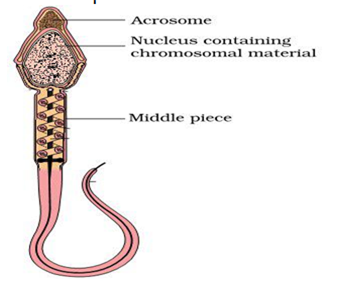How is the entry of only one sperm and not many ensured into an ovum during fertilisation in humans?
During fertilisation, a sperm comes in contact with the zona pellucida layer of the ovum and with the help of acrosomal secretions induces changes in the membrane that block the entry of additional sperms. Thus, it ensures that only one sperm can fertilise an ovum
Draw a diagram of the microscopic structure of human sperm. Label the following parts in it and write their functions.
(a) Acrosome
(b) Nucleus
(c) Middle piece
Microscopic structure of human sperm
Function of Acrosome -
It contains enzymes that help the sperm to enter and to fertilise the ovum.
Function of Nucleus -
It stores the genetic information. It carries 23 chromosomes, out of which one is sex chromosome (either X or Y). Thus, it is responsible for determining the sex of the individual.
Function of Middle piece -
The middle piece contains several mitochondria, which produce energy for the movement of the tail and motility of the sperm.
Why are the human testes located outside the abdominal cavity? Name the pouch in which they are present.
Human testes are located outside the abdominal cavity for maintaining low temperature (2–2.5o C lower than the normal internal body temperature) necessary for spermatogenesis.
The pouch in which they are present. is called Scrotal sacs.
Write the function of each one of the following:
(a) (Oviducal) Fimbriae
(b) Coleoptile
(c) Oxytocin(a) Fimbriae are the finger-like processes present at the end of the fallopian tubes
(b) Coleoptile is a conical sheath present in the monocot seeds; its function is to protect the developing plumule.
(c) Oxytocin is a hormone secreted by the posterior pituitary and it stimulates the contraction of uterine muscles during child birth (parturition).
